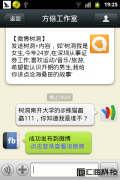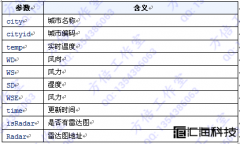此文章为转载:http://blog.csdn.net/pamchen/article/details/38718947
版权声明:本文为博主原创文章,未经博主允许不得转载。
目录(?)[-]
- 1 在登录微信官方平台之后开启开发者模式此时需要我们填写url和token所谓url就是我们自己服务器的接口用WechatServletjava来实现相关解释已经在注释中说明代码如下
- 2 相应的webxml配置信息如下在生成WechatServletjava的同时可自动生成webxml中的配置前面所提到的url处可以填写例如http服务器地址项目名wechatdo
- 3 通过以上代码我们已经实现了微信公众平台开发的框架即开通开发者模式并成功接入接收消息和发送消息这三个步骤
- 3 调用图灵机器人api接口获取智能回复内容
- 4 将结果封装为微信规定的xml格式并返回给11中创建的servlet接口
说明:
本次的教程主要是对微信公众平台开发者模式的讲解,网络上很多类似文章,但很多都让初学微信开发的人一头雾水,所以总结自己的微信开发经验,将微信开发的整个过程系统的列出,并对主要代码进行讲解分析,让初学者尽快上手。
在阅读本文之前,应对微信公众平台的官方开发文档有所了解,知道接收和发送的都是xml格式的数据。另外,在做内容回复时用到了图灵机器人的api接口,这是一个自然语言解析的开放平台,可以帮我们解决整个微信开发过程中最困难的问题,此处不多讲,下面会有其详细的调用方式。
1.1 在登录微信官方平台之后,开启开发者模式,此时需要我们填写url和token,所谓url就是我们自己服务器的接口,用WechatServlet.java来实现,相关解释已经在注释中说明,代码如下: [java] view plain copy print?
- package demo.servlet;
- import java.io.BufferedReader;
- import java.io.IOException;
- import java.io.InputStream;
- import java.io.InputStreamReader;
- import java.io.OutputStream;
- import javax.servlet.ServletException;
- import javax.servlet.http.HttpServlet;
- import javax.servlet.http.HttpServletRequest;
- import javax.servlet.http.HttpServletResponse;
- import demo.process.WechatProcess;
- /**
- * 微信服务端收发消息接口
- *
- * @author pamchen-1
- *
- */
- public class WechatServlet extends HttpServlet {
- /**
- * The doGet method of the servlet.
- *
- * This method is called when a form has its tag value method equals to get.
- *
- * @param request
- * the request send by the client to the server
- * @param response
- * the response send by the server to the client
- * @throws ServletException
- * if an error occurred
- * @throws IOException
- * if an error occurred
- */
- public void doGet(HttpServletRequest request, HttpServletResponse response)
- throws ServletException, IOException {
- request.setCharacterEncoding("UTF-8");
- response.setCharacterEncoding("UTF-8");
- /** 读取接收到的xml消息 */
- StringBuffer sb = new StringBuffer();
- InputStream is = request.getInputStream();
- InputStreamReader isr = new InputStreamReader(is, "UTF-8");
- BufferedReader br = new BufferedReader(isr);
- String s = "";
- while ((s = br.readLine()) != null) {
- sb.append(s);
- }
- String xml = sb.toString(); //次即为接收到微信端发送过来的xml数据
- String result = "";
- /** 判断是否是微信接入激活验证,只有首次接入验证时才会收到echostr参数,此时需要把它直接返回 */
- String echostr = request.getParameter("echostr");
- if (echostr != null && echostr.length() > 1) {
- result = echostr;
- } else {
- //正常的微信处理流程
- result = new WechatProcess().processWechatMag(xml);
- }
- try {
- OutputStream os = response.getOutputStream();
- os.write(result.getBytes("UTF-8"));
- os.flush();
- os.close();
- } catch (Exception e) {
- e.printStackTrace();
- }
- }
- /**
- * The doPost method of the servlet.
- *
- * This method is called when a form has its tag value method equals to
- * post.
- *
- * @param request
- * the request send by the client to the server
- * @param response
- * the response send by the server to the client
- * @throws ServletException
- * if an error occurred
- * @throws IOException
- * if an error occurred
- */
- public void doPost(HttpServletRequest request, HttpServletResponse response)
- throws ServletException, IOException {
- doGet(request, response);
- }
- }
1.2 相应的web.xml配置信息如下,在生成WechatServlet.java的同时,可自动生成web.xml中的配置。前面所提到的url处可以填写例如:http;//服务器地址/项目名/wechat.do [html] view plain copy print?
- xmlns="http://java.sun.com/xml/ns/javaee"
- xmlns:xsi="http://www.w3.org/2001/XMLSchema-instance"
- xsi:schemaLocation="http://java.sun.com/xml/ns/javaee
- http://java.sun.com/xml/ns/javaee/web-app_2_5.xsd">
This is the description of my J2EE component This is the display name of my J2EE component WechatServlet demo.servlet.WechatServlet WechatServlet /wechat.do index.jsp
1.3 通过以上代码,我们已经实现了微信公众平台开发的框架,即开通开发者模式并成功接入、接收消息和发送消息这三个步骤。
下面就讲解其核心部分——解析接收到的xml数据,并以文本类消息为例,通过图灵机器人api接口实现智能回复。
2.1 首先看一下整体流程处理代码,包括:xml数据处理、调用图灵api、封装返回的xml数据。
[java] view plain copy print?
- package demo.process;
- import java.util.Date;
- import demo.entity.ReceiveXmlEntity;
- /**
- * 微信xml消息处理流程逻辑类
- * @author pamchen-1
- *
- */
- public class WechatProcess {
- /**
- * 解析处理xml、获取智能回复结果(通过图灵机器人api接口)
- * @param xml 接收到的微信数据
- * @return 最终的解析结果(xml格式数据)
- */
- public String processWechatMag(String xml){
- /** 解析xml数据 */
- ReceiveXmlEntity xmlEntity = new ReceiveXmlProcess().getMsgEntity(xml);
- /** 以文本消息为例,调用图灵机器人api接口,获取回复内容 */
- String result = "";
- if("text".endsWith(xmlEntity.getMsgType())){
- result = new TulingApiProcess().getTulingResult(xmlEntity.getContent());
- }
- /** 此时,如果用户输入的是“你好”,在经过上面的过程之后,result为“你也好”类似的内容
- * 因为最终回复给微信的也是xml格式的数据,所有需要将其封装为文本类型返回消息
- * */
- result = new FormatXmlProcess().formatXmlAnswer(xmlEntity.getFromUserName(), xmlEntity.getToUserName(), result);
- return result;
- }
- }
2.2 解析接收到的xml数据,此处有两个类,ReceiveXmlEntity.java和ReceiveXmlProcess.java,通过反射的机制动态调用实体类中的set方法,可以避免很多重复的判断,提高代码效率,代码如下: [java] view plain copy print?
- package demo.entity;
- /**
- * 接收到的微信xml实体类
- * @author pamchen-1
- *
- */
- public class ReceiveXmlEntity {
- private String ToUserName="";
- private String FromUserName="";
- private String CreateTime="";
- private String MsgType="";
- private String MsgId="";
- private String Event="";
- private String EventKey="";
- private String Ticket="";
- private String Latitude="";
- private String Longitude="";
- private String Precision="";
- private String PicUrl="";
- private String MediaId="";
- private String Title="";
- private String Description="";
- private String Url="";
- private String Location_X="";
- private String Location_Y="";
- private String Scale="";
- private String Label="";
- private String Content="";
- private String Format="";
- private String Recognition="";
- public String getRecognition() {
- return Recognition;
- }
- public void setRecognition(String recognition) {
- Recognition = recognition;
- }
- public String getFormat() {
- return Format;
- }
- public void setFormat(String format) {
- Format = format;
- }
- public String getContent() {
- return Content;
- }
- public void setContent(String content) {
- Content = content;
- }
- public String getLocation_X() {
- return Location_X;
- }
- public void setLocation_X(String locationX) {
- Location_X = locationX;
- }
- public String getLocation_Y() {
- return Location_Y;
- }
- public void setLocation_Y(String locationY) {
- Location_Y = locationY;
- }
- public String getScale() {
- return Scale;
- }
- public void setScale(String scale) {
- Scale = scale;
- }
- public String getLabel() {
- return Label;
- }
- public void setLabel(String label) {
- Label = label;
- }
- public String getTitle() {
- return Title;
- }
- public void setTitle(String title) {
- Title = title;
- }
- public String getDescription() {
- return Description;
- }
- public void setDescription(String description) {
- Description = description;
- }
- public String getUrl() {
- return Url;
- }
- public void setUrl(String url) {
- Url = url;
- }
- public String getPicUrl() {
- return PicUrl;
- }
- public void setPicUrl(String picUrl) {
- PicUrl = picUrl;
- }
- public String getMediaId() {
- return MediaId;
- }
- public void setMediaId(String mediaId) {
- MediaId = mediaId;
- }
- public String getEventKey() {
- return EventKey;
- }
- public void setEventKey(String eventKey) {
- EventKey = eventKey;
- }
- public String getTicket() {
- return Ticket;
- }
- public void setTicket(String ticket) {
- Ticket = ticket;
- }
- public String getLatitude() {
- return Latitude;
- }
- public void setLatitude(String latitude) {
- Latitude = latitude;
- }
- public String getLongitude() {
- return Longitude;
- }
- public void setLongitude(String longitude) {
- Longitude = longitude;
- }
- public String getPrecision() {
- return Precision;
- }
- public void setPrecision(String precision) {
- Precision = precision;
- }
- public String getEvent() {
- return Event;
- }
- public void setEvent(String event) {
- Event = event;
- }
- public String getMsgId() {
- return MsgId;
- }
- public void setMsgId(String msgId) {
- MsgId = msgId;
- }
- public String getToUserName() {
- return ToUserName;
- }
- public void setToUserName(String toUserName) {
- ToUserName = toUserName;
- }
- public String getFromUserName() {
- return FromUserName;
- }
- public void setFromUserName(String fromUserName) {
- FromUserName = fromUserName;
- }
- public String getCreateTime() {
- return CreateTime;
- }
- public void setCreateTime(String createTime) {
- CreateTime = createTime;
- }
- public String getMsgType() {
- return MsgType;
- }
- public void setMsgType(String msgType) {
- MsgType = msgType;
- }
- }
[java] view plain copy print?
- package demo.process;
- import java.lang.reflect.Field;
- import java.lang.reflect.Method;
- import java.util.Iterator;
- import org.dom4j.Document;
- import org.dom4j.DocumentHelper;
- import org.dom4j.Element;
- import demo.entity.ReceiveXmlEntity;
- /**
- * 解析接收到的微信xml,返回消息对象
- * @author pamchen-1
- *
- */
- public class ReceiveXmlProcess {
- /**
- * 解析微信xml消息
- * @param strXml
- * @return
- */
- public ReceiveXmlEntity getMsgEntity(String strXml){
- ReceiveXmlEntity msg = null;
- try {
- if (strXml.length() <= 0 || strXml == null)
- return null;
- // 将字符串转化为XML文档对象
- Document document = DocumentHelper.parseText(strXml);
- // 获得文档的根节点
- Element root = document.getRootElement();
- // 遍历根节点下所有子节点
- Iterator iter = root.elementIterator();
- // 遍历所有结点
- msg = new ReceiveXmlEntity();
- //利用反射机制,调用set方法
- //获取该实体的元类型
- Class c = Class.forName("demo.entity.ReceiveXmlEntity");
- msg = (ReceiveXmlEntity)c.newInstance();//创建这个实体的对象
- while(iter.hasNext()){
- Element ele = (Element)iter.next();
- //获取set方法中的参数字段(实体类的属性)
- Field field = c.getDeclaredField(ele.getName());
- //获取set方法,field.getType())获取它的参数数据类型
- Method method = c.getDeclaredMethod("set"+ele.getName(), field.getType());
- //调用set方法
- method.invoke(msg, ele.getText());
- }
- } catch (Exception e) {
- // TODO: handle exception
- System.out.println("xml 格式异常: "+ strXml);
- e.printStackTrace();
- }
- return msg;
- }
- }
2.3 调用图灵机器人api接口,获取智能回复内容: [java] view plain copy print?
- package demo.process;
- import java.io.IOException;
- import java.io.UnsupportedEncodingException;
- import java.net.URLEncoder;
- import org.apache.http.HttpResponse;
- import org.apache.http.client.ClientProtocolException;
- import org.apache.http.client.methods.HttpGet;
- import org.apache.http.impl.client.HttpClients;
- import org.apache.http.util.EntityUtils;
- import org.json.JSONException;
- import org.json.JSONObject;
- /**
- * 调用图灵机器人api接口,获取智能回复内容
- * @author pamchen-1
- *
- */
- public class TulingApiProcess {
- /**
- * 调用图灵机器人api接口,获取智能回复内容,解析获取自己所需结果
- * @param content
- * @return
- */
- public String getTulingResult(String content){
- /** 此处为图灵api接口,参数key需要自己去注册申请,先以11111111代替 */
- String apiUrl = "http://www.tuling123.com/openapi/api?key=11111111&info=";
- String param = "";
- try {
- param = apiUrl+URLEncoder.encode(content,"utf-8");
- } catch (UnsupportedEncodingException e1) {
- // TODO Auto-generated catch block
- e1.printStackTrace();
- } //将参数转为url编码
- /** 发送httpget请求 */
- HttpGet request = new HttpGet(param);
- String result = "";
- try {
- HttpResponse response = HttpClients.createDefault().execute(request);
- if(response.getStatusLine().getStatusCode()==200){
- result = EntityUtils.toString(response.getEntity());
- }
- } catch (ClientProtocolException e) {
- e.printStackTrace();
- } catch (IOException e) {
- e.printStackTrace();
- }
- /** 请求失败处理 */
- if(null==result){
- return "对不起,你说的话真是太高深了……";
- }
- try {
- JSONObject json = new JSONObject(result);
- //以code=100000为例,参考图灵机器人api文档
- if(100000==json.getInt("code")){
- result = json.getString("text");
- }
- } catch (JSONException e) {
- // TODO Auto-generated catch block
- e.printStackTrace();
- }
- return result;
- }
- }
2.4 将结果封装为微信规定的xml格式,并返回给1.1中创建的servlet接口。 [java] view plain copy print?
- package demo.process;
- import java.util.Date;
- /**
- * 封装最终的xml格式结果
- * @author pamchen-1
- *
- */
- public class FormatXmlProcess {
- /**
- * 封装文字类的返回消息
- * @param to
- * @param from
- * @param content
- * @return
- */
- public String formatXmlAnswer(String to, String from, String content) {
- StringBuffer sb = new StringBuffer();
- Date date = new Date();
- sb.append("
- sb.append(to);
- sb.append("]]>
- sb.append(from);
- sb.append("]]>
"); - sb.append(date.getTime());
- sb.append("
- sb.append(content);
- sb.append("]]>
0 "); - return sb.toString();
- }
- }
总结,以上便是微信公众平台开发的全部流程,整体来看并不复杂,要非常感谢图灵机器人提供的api接口,帮我们解决了智能回复这一高难度问题。其他类型的消息处理与示例中类似,有兴趣的开发者可以联系我进行交流学习,希望本文对大家有所帮助。
本问中的代码示例已经上传到了csdn的个人资源中,有需要的可以去下载:http://download.csdn.net/detail/pamchen/7793979













